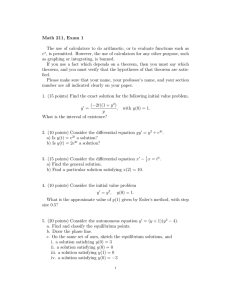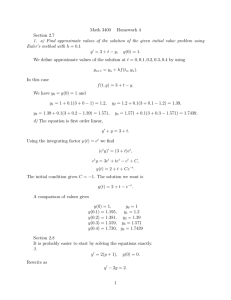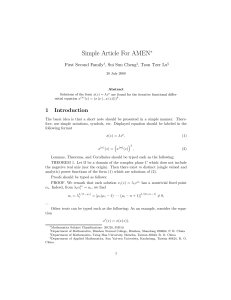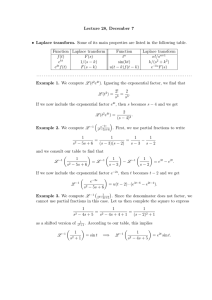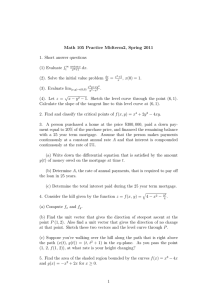Math 211, Exam 1 e
advertisement
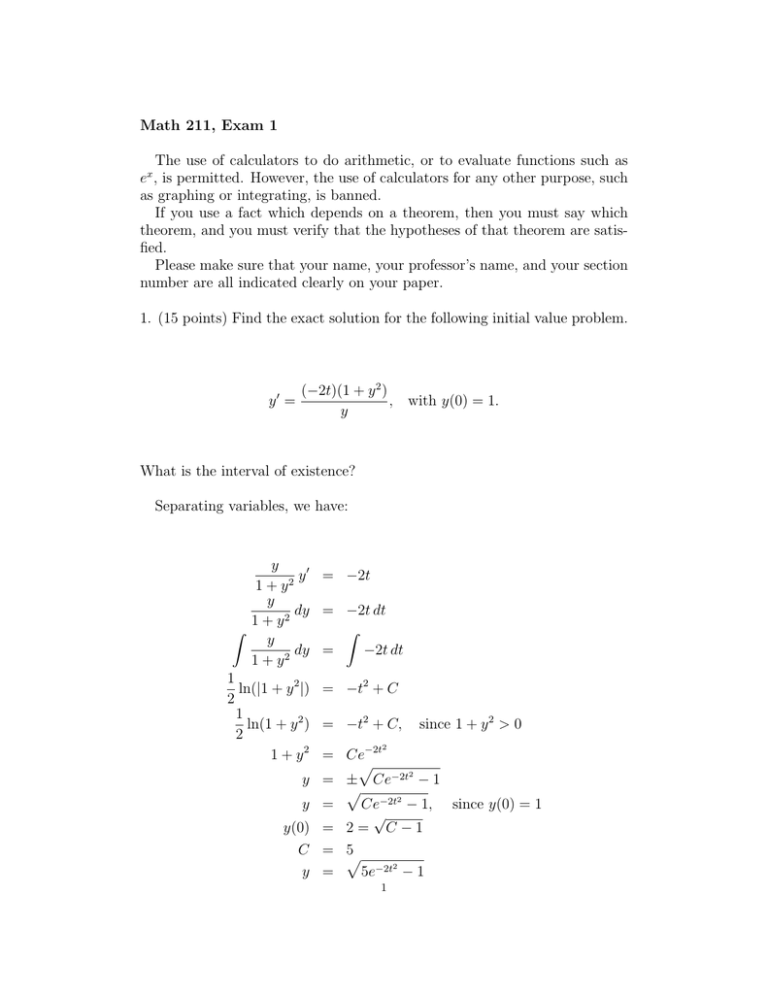
Math 211, Exam 1 The use of calculators to do arithmetic, or to evaluate functions such as e , is permitted. However, the use of calculators for any other purpose, such as graphing or integrating, is banned. If you use a fact which depends on a theorem, then you must say which theorem, and you must verify that the hypotheses of that theorem are satisfied. Please make sure that your name, your professor’s name, and your section number are all indicated clearly on your paper. x 1. (15 points) Find the exact solution for the following initial value problem. y = (−2t)(1 + y 2 ) , y with y(0) = 1. What is the interval of existence? Separating variables, we have: y y = −2t 1 + y2 y dy = −2t dt 1 + y2 y dy = −2t dt 1 + y2 1 ln(|1 + y 2 |) = −t2 + C 2 1 ln(1 + y 2 ) = −t2 + C, since 1 + y 2 > 0 2 2 1 + y 2 = Ce−2t y = ± Ce−2t2 − 1 Ce−2t2 − 1, since y(0) = 1 y = √ y(0) = 2 = C − 1 C = 5 y = 5e−2t2 − 1 1 2 For the interval of existence, we note that, for the square root to be defined, we must have: 2 5e−2t − 1 2 e−2t −2t2 t2 ≥ ≥ ≥ ≤ 0 1/5 ln(1/5) − ln(1/5)/2 t ≤ − ln(1/5)/2, and t ≥ − − ln(1/5)/2 So the interval of existence is (− − ln(1/5)/2, − ln(1/5)/2). 2. (10 points) Consider the differential equation yy = y 2 + e4t . a) Is y(t) = e2t a solution? b) Is y(t) = 2e2t a solution? a) If y(t) = e2t , then the left hand side becomes: y y = e2t (e2t ) = 2e2t e2t = 2e4t , and the right hand side becomes: y 2 + e4t = (e2t )2 + e4t = e4t + e4t = 2e4t . Since we get the same thing on both sides, y(t) = e2t is a solution. b) If y(t) = 2e2t , then the left hand side becomes: y y = (2e2t )(2e2t ) = 4e4t , and the right hand side becomes: y 2 + e4t = (2e2t )2 + e4t = 4e4t + e4t = 5e4t . So we get different functions on the two sides, and so y(t) = 2e2t is not a solution. 3. (15 points) Consider the differential equation x − 1t x = t4 . 3 a) Find the general solution. b) Find a particular solution satisfying x(2) = 10. This is a linear, non-homogeneous differential equation. We compute the integrating factor as: −1 dt u(t) = exp t = e− ln(|t|) = e− ln(t) , 1 = t since initial condition is t = 2 > 0 Multiplying both sides of the differenetial equation by u(t) gives: 1 1 (x − x) t t 1 1 x − 2x t t 1 ( x) t 1 x t 1 x t = 1 4 t t = t3 = t3 = t3 dt = x = x(2) = C = x = 1 4 t +C 4 t5 + Ct 4 32 + C(2) = 10 4 1 t5 +t 4 4. (10 points) Consider the initial value problem y = y2, y(0) = 1. What is the approximate value of y(1) given by Euler’s method, with step size 0.5? 4 Euler’s method gives the following sequence of points: (t0 , y0 ) = (0, 1) (t1 , y1 ) = (t0 + h, y0 + hf (t0 , y0 )) = (.5, 1 + .5(1)2 )) = (.5, 1.5) (t2 , y2 ) = (t1 + h, y1 + hf (t1 , y1 )) = (1, 1.5 + .5(1.5)2 ) = (1, 2.625) So Euler’s method gives y(1) approximately equal to 2.625. 5. (20 points) Consider the autonomous equation y = (y + 1)(y 2 − 4). a. Find and classify the equilibrium points. To find the equilibrium points, we solve: (y + 1)(y 2 − 4) = 0, obtaining the solutions y = −1, y = 2, and y = −2. Then y = −1 is stable, y = 2 and y = −2 are unstable. b. Draw the phase line. c. On the same set of axes, sketch the equilibrium solutions, and i. a solution satisfying y(0) = 3 ii. a solution satisfying y(0) = 0 iii. a solution satisfying y(1) = 0 iv. a solution satisfying y(0) = −3 6. (15 points) Consider the differential equation y = y 2 − y − ye−t . a) Show that y1 (t) = e−t is a solution. We have y1 = −e−t y12 − y1 − y1 e−t = e−2t − e−t − e−2t = −e−t , so y1 is a solution. 5 Phase line f(y) 2 y -1 -2 2 -1 -2 3 i 2 ii iii 1 2 t -1 -2 -3 iv y b) Find a solution of the form y = constant. If we set y 2 − y − ye−t = 0, we find that y = 0 is a solution. 6 c) Sketch the solutions from part a) and b) on the same set of axes. 150 100 50 0 −5 −4 −3 −2 −1 0 1 2 3 4 5 d) Suppose that y(t) is a solution for which 0 ≤ y(0) ≤ 1. Show that y(t) → 0 as t → ∞. The function y 2 − y − ye−t has a continuous partial derivative with respect to y. Therefore the hypothesis of the Uniqueness Theorem is satisfied. This theorem implies that no two solution curves for this differential equation can cross. In particular, a solution y(t) with 0 < y(0) < 1 must always remain between the two solution curves y1 (t) and the constant solution 0. Since these both approach 0 as t approaches ∞, the squeeze theorem implies that y(t) → 0 as well. 7. (15 points) Suppose that you’re currently paying $1200/month to rent your 2-bedroom house. If you were to put that rent money toward a house mortgage instead, what price of house could you afford? Assume a 30 year mortgage with a 7% interest rate, compounded continuously, and that your payments are made continuously, at a constant rate. Note: A “mortgage” just means a loan from the bank. You must pay interest on the loan at a rate of 7%, and the loan must be completely paid off at the end of 30 years. 7 Let B(t) denote the balance in the mortgage after t years. The assumptions in the problem translate to the following differential equation: B = .07 B − α, where α is the rate at which payments are made. Applying all the rent money to the payments gives α = 1200 ∗ 12 = 14, 400/year. We then solve the equation, by first computing the integrating differential factor u(t) = exp −.07 dt = e−.07t . Then we have: e−.07t (B − .07B) = e−.07t (−α) e−.07t B − .07Be−.07t = −αe−.07t (e−.07t B) = −αe−.07t −.07t e B = −α e−.07t dt e−.07t B = (α/.07)e−.07t + C B = α/.07 + Ce.07t Since the loan must be paid off in 30 years, we have B(30) = 0 α/.07 + Ce(.07)30 = 0 C = −(α/.07)e−(.07)30 C = −25, 191 The amount of money we can spend on the house is therefore: B(0) = (α/.07) + C = 180, 523
